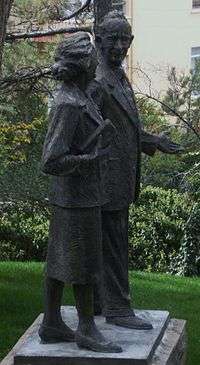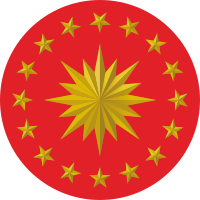Mevhibe İnönü
Mevhibe İnönü (September 22, 1897 – February 29, 1992) was the First Lady of Turkey from November 11, 1938 until May 27, 1950 during the presidency of her husband İsmet İnönü.
Mevhibe İnönü | |
|---|---|
.jpg) | |
| First Lady of Turkey | |
| In role November 11, 1938 – May 27, 1950 | |
| President | İsmet İnönü |
| Preceded by | Latife Uşşaki |
| Succeeded by | Reşide Bayar |
| Personal details | |
| Born | September 22, 1897 Fatih, Istanbul |
| Died | February 29, 1992 (aged 94) Keçiören, Ankara |
| Resting place | Cebeci Asri Cemetery |
| Nationality | Turkish |
| Spouse(s) | İsmet İnönü (m. 1916) |
| Children | 4, including Erdal |
Early years
She was born on September 22, 1897 at Süleymaniye neighborhood of Fatih district in Istanbul. Her father died of tuberculosis as she was three years old. Shortly later, her sibling also died. Following the losses in the family, Mevhibe's mother moved with her to the grandfather's house, where she was raised then on. She left the secondary school after the first grade due to the family's decision.
She married on April 13, 1916 to Mustafa İsmet, an officer of the Ottoman Army in the rank of colonel (Ottoman Turkish: Miralay). 21 days later, her husband left for the front at the Middle Eastern theatre of World War I to return home only after the conclusion of Armistice of Mudros on October 30, 1918.
The couple's first son was born in 1919. Mustafa İsmet went in 1920 to Anatolia to join the Turkish War of Independence. As being the spouse of an officer, who was sentenced to death by the Ottoman administration for his involvement in the national resistance, Mevhibe moved together with her family members to her husband's hometown Malatya, and remained there in the years of the struggle. Her son İzzet died in 1921 during that time.
The family settled in İzmir shortly after its re-capture by the Turkish troops on September 9, 1922. During the negotiations of the Treaty of Lausanne that lasted eleven weeks from November 1922, she accompanied her husband in Switzerland, who was the head of the Turkish delegation. In 1924, she mothered her second son Ömer. That year, she moved into Pembe Köşk in Ankara, which her husband purchased newly.[1] The mansion became their home until 1975. In 1926, their third son Erdal, and then in 1930 the couple's daughter Özden was born. Mevhibe İnönü visited several places including Athens, Moscow and Rome as the prime minister's spouse.
In 1934, the Surname Law came into effect. Mustafa İsmet and his family members received the family name İnönü in honor of the First and Second Battle of İnönü, he was a victorious commander of.
First lady

Following the death of Mustafa Kemal Atatürk on November 10, 1938, the founder and the first president of the Turkish Republic, İsmet İnönü was elected president the next day. Mevhibe İnönü moved then as the second first lady into Çankaya Köşkü, the official presidential residence, where she stayed until May 27, 1950.
Personal interests
She was known as a polite and elegant woman.[1] She co-founded in 1928 "Yardımsevenler Derneği" (Association of Humanists) and in 1949 "Türk Kadınlar Birliği" (Union of Turkish Women). In 1983, she and her children set up a foundation in honor of their late family father İsmet İnönü. She became the first chairperson of the board of trustees of the İnönü Foundation.[2]
Later years
Mevhibe İnönü lost on December 25, 1973 her husband, who played a long and important role in the Turkish politics. On July 20, 1991, she was hospitalized in the military hospital GATA in Ankara, where she died on February 29, 1992. She was laid to rest at the Cebeci Asri Cemetery in Ankara.
References
- Temur, Şahika (2009-11-09). "An elegant journey with the Republic's second lady". Hürriyet Daily News. Retrieved 2010-11-01.
- "İnönü Vakfı" (in Turkish). İsmet İnönü. Archived from the original on 2008-12-31. Retrieved 2010-11-01.
Further reading
- Mevhibe İnönü: örnek bir Cumhuriyet kadını. T.C. Kültür Bakanlıǧı. 1996.
